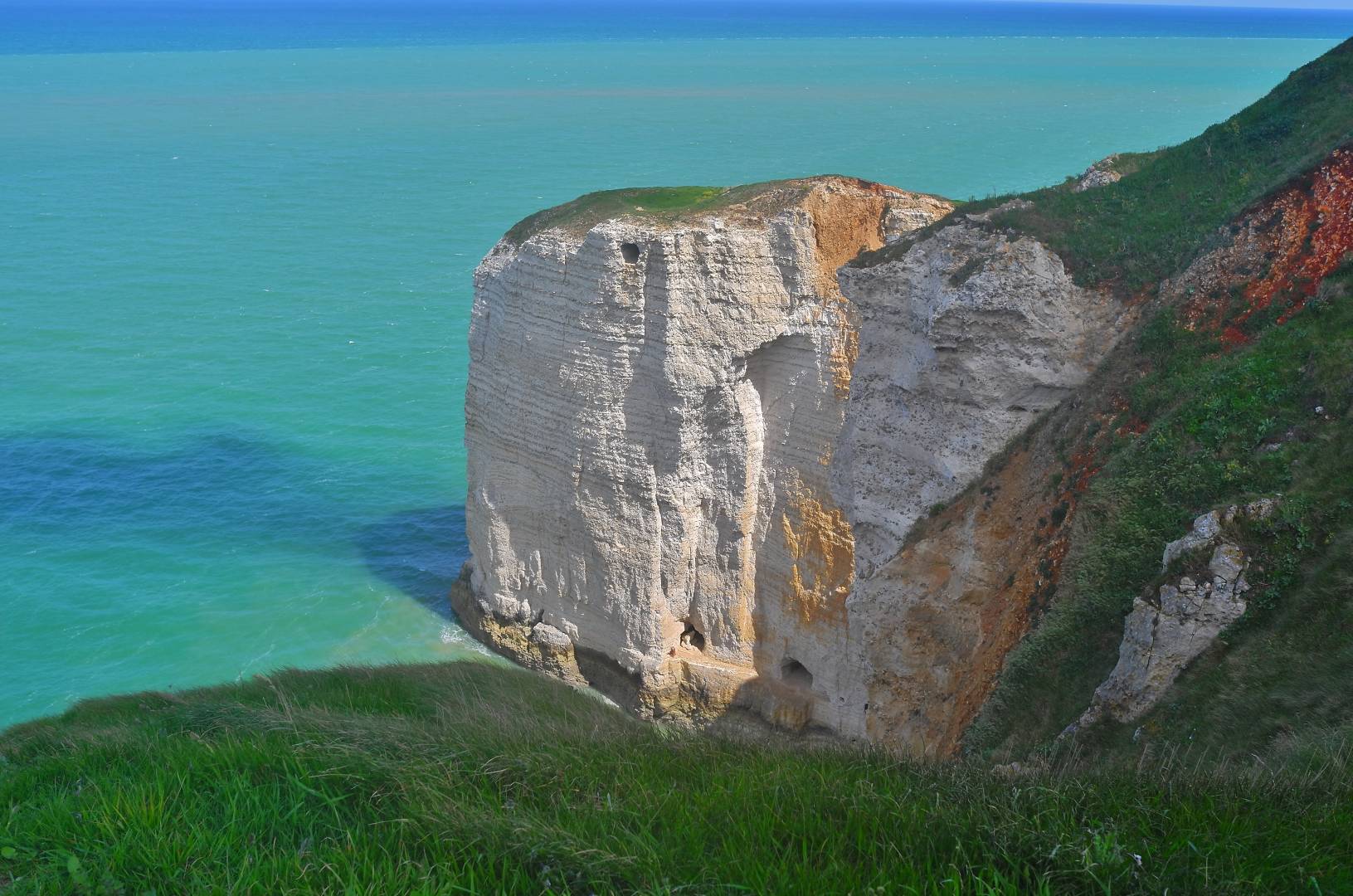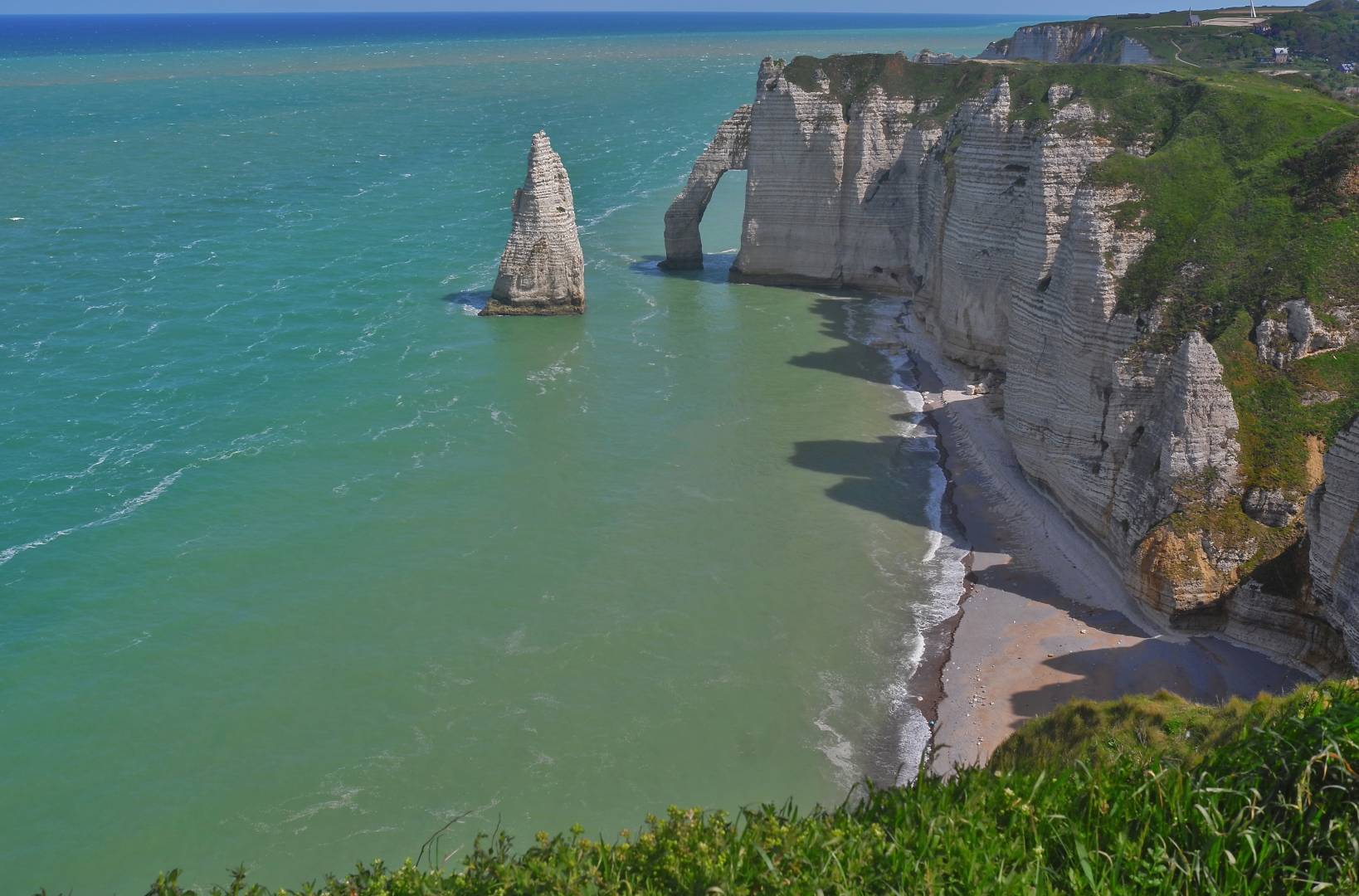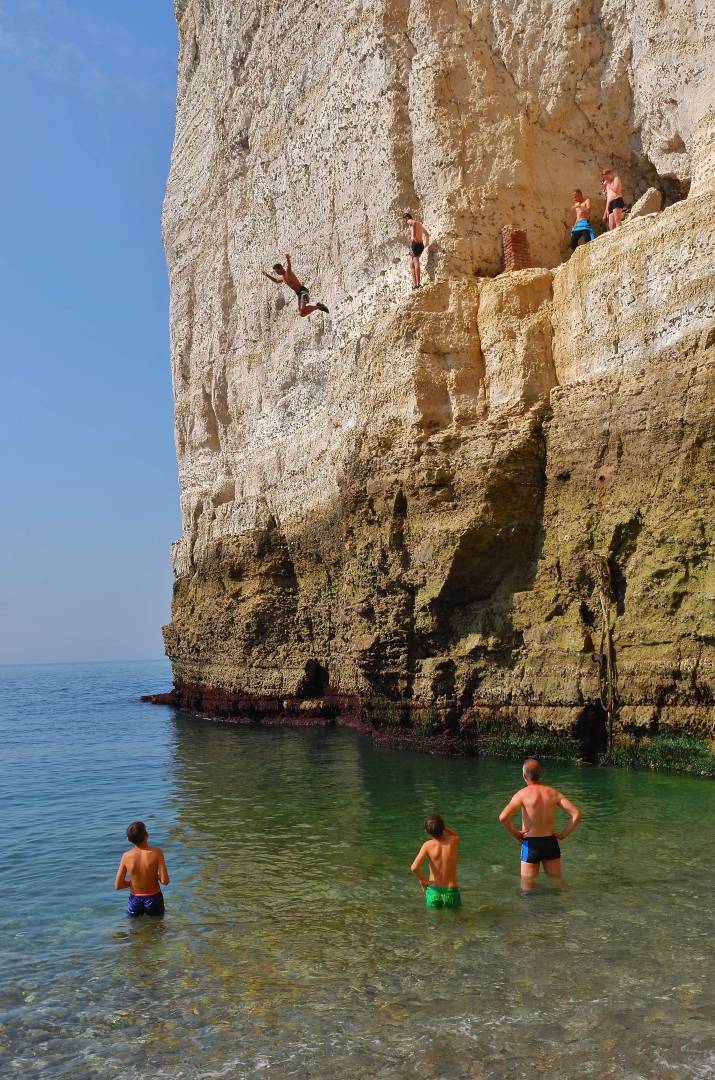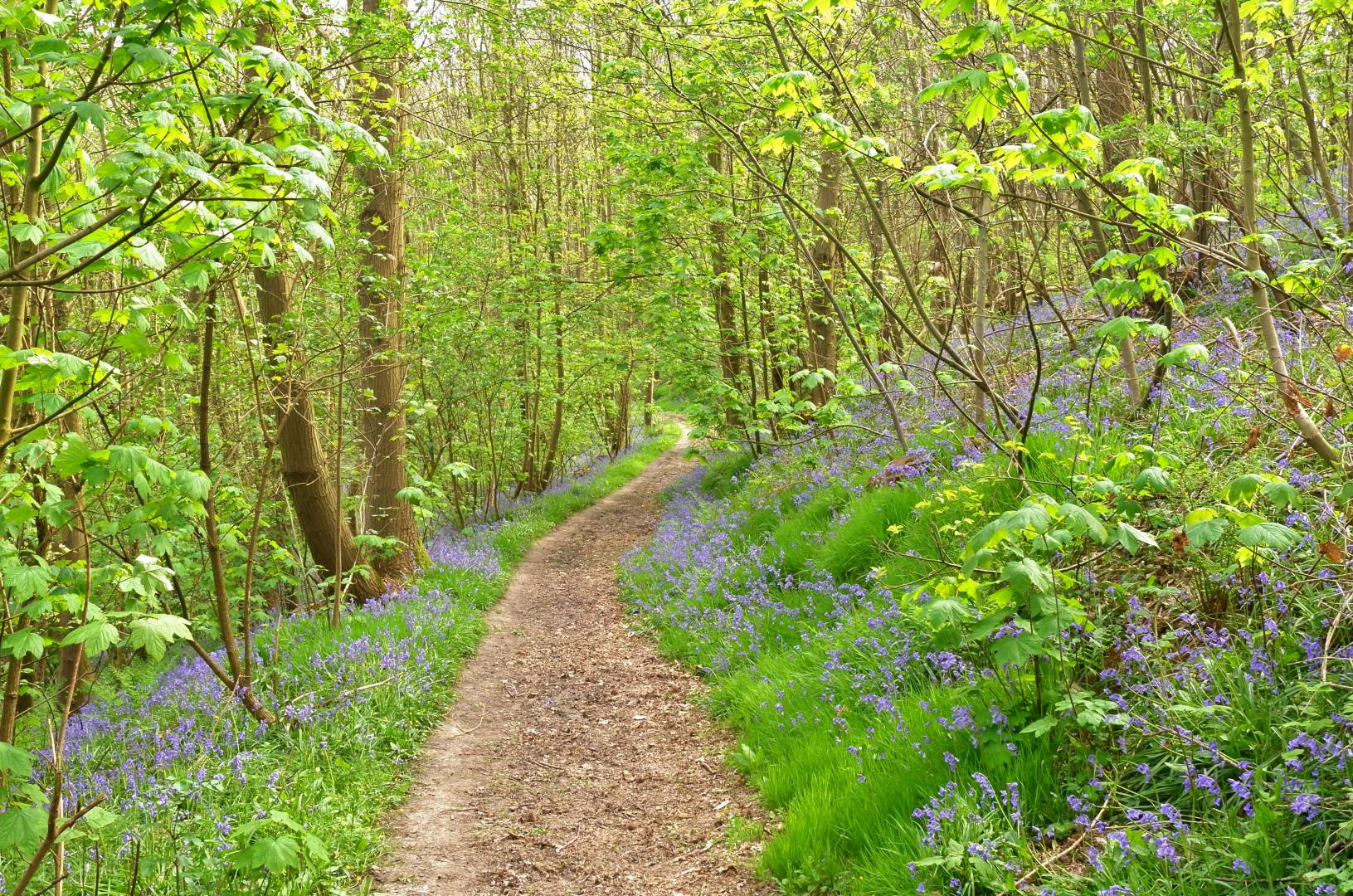Mention Normandy outside France and the first image that springs to mind is “beaches”. The Normandy beaches have become a sort of icon for the beginning of the end of the Second World War. And for the British, Normandy also brings echoes of 1066 and all that — when some Norman king, tinged with Viking blood, did a reverse landing and conquered England.
Although we live about a 100 kilometres from the D-Day beaches, these clichés overlook something that is obvious to all us latter-day locals: the fact that we are blessed with one of the most beautiful coastlines in the world.
Based in Le Havre, we enjoy a long sea coast, stretching over 100 miles from the estuaries of the Seine and the Somme. This part of Normandy must have been attached to south east England ( from Dover to the Jurassic coast) at the time of the Pangaea super continent. A geologist friend explained that Britain got separated from France after a giant tsunami that happened millions of years ago. This white cliff coastline boasts “Operation Biting”, a successful raid by the RAF in February 1942 when the British destroyed the German radar that controlled most of the Channel area during WW2.
As avid walkers, my wife and I never cease to marvel at our surroundings. The sea coast consists largely of cliffs and small valleys, known in the local dialect as “valleuses”, which always lead to rocky beaches. The valleys are often covered with trees while, on the upper ground, a flatland atop the cliffs gives way to cultivated fields. The constantly changing light at all seasons of the year is amazing and it is no wonder that it inspired impressionists such as Claude Monet, Camille Pissarro and Eugène Boudin, just to name a few, more than a century ago.
These days, my chosen tool to capture the changes of light and the various colours of the sea is the humble old Leica X2, an out-dated, fixed 36mm (equivalent) pocket camera that still produces outstanding results.
So what are some of our personal highlights of this unique stretch of coastline? We can recommend two special areas if you are inclined to try a walking holiday with a difference.
Yport
A pretty former fishing village, Yport lies 25 miles north of Le Havre. The road descends through a wooded valley to the village before leading through the town to the seafront. The community itself consists of two parallel streets. It was first settled in the 5th century, at the end of the Roman occupation of Gaul but the real development came in the 19th century.
It was then a fishing port and seaside resort, taking the lead in the new fashion of sea bathing. Yport remains a popular summer resort, with its casino and seafood restaurants. As an aside, it is the haunt of Magnum photographer Jean Gaumy who was born in the neighbourhood.
Although the last professional fishermen disappeared at the end of the 1960s, some amateur anglers still have their boats stranded on the beach. The boats are pulled to the upper part of the beach by means of capstans. They are a wonderful reminder of past times when the beach harboured a fleet of 50 small fishing boats with their nets and creels.
Le Tilleul
This “coastal-protected area” is our all-year-round local favourite walk. From the car park, a pedestrian walk descends directly through the beach. It starts in a wooded valley covered with wild hyacinths in the spring time. Instead of going directly to the beach, walkers can follow a path to the right which climbs up again through a small wood.

The path on higher ground is traced between fields. After two turns left, you finally reach the top of the cliff. Once you reach a tee-junction you may decide to take the path along the cliffs on your right which leads to Etretat. The walk is pleasant and allows you to watch the various arches and needles Etretat is famous for. The blue of the sea with the white cliffs and the green grass provides a truly amazing, ever-changing backdrop at all seasons of the year.
If you take the path to the left, you will end up the beach of Le Tilleul. From there you can walk to the keyhole where cliff divers climb. The keyhole also allows you to go to another secluded beach which can be reached thanks to a ladder and a small path carved in the cliff. If you are prone to vertigo this should be avoided. Unfortunately, on our last visit we discovered that the access to the keyhole had collapsed due to coastal erosion.
Back from the beach, you can avoid the crowd by taking a path returning to the cliff top and through a wooded vale, and thus back to the starting point.
All these images have been taken over the four years since I bought my Leica X2. This is my camera of choice because it is the ideal camera to capture the various hues of the land and seascape at any season of the year. It is also light and compact, an advantage when walking. The 36 mm (equivalent) f/2.8 Elmarit lens has just the perfect field of view for this walk. Somehow, too, the lens always succeeds in making the water seem crystal clear.






















Thanks Alan for your comment. Normandy landscapes are really varied within a relatively small area. I have been living there for 35 years and haven’t explored all the inland areas.
Thanks for your post, it brought back memories of three glories days that I spent in Normandy. I was in Bordeaux over from the US on a short business trip. After my work was completed I headed to the Normandy Coast to visit areas of historical significance. While spending my days traveling from place to place I developed an appreciation as to why the region was selected for the cross channel invasion….I now believe that the region was selected because of its spectacular scenery 🙂 I remember sitting in a field at the end of a day photographing in fine light. Dinner was included with my lodging but to make it back In time I would have rush back to town. Fortunately I made the right choice and remained in the field breathing in the beauty and slowing down until after dark. My dinner turned out to be a left over roll but my heart and soul was well fed. I long for a return visit
I far, far prefer to read these kinds of stories than the ‘glossy media’ stuff- and equivalents- today. It’s so enjoyable to get the map out and follow along, despite being 5500 Km away and unlikely I’ll be taking a casual stroll there anytime soon!
Look forward to part two, three, four, etc.
Thanks Bob for the kind comment. Unfortunately next article will be on Nepal some 24 hours flight from home.
Thanks Kevin,the cliff divers will soon be back and I’ll probably go to exercise myself with a different angle next time. The combo X2 + Ricoh GRD4 is what I usually take to get the 28mm FOV. I’ve thought of a TL2 and 18 elmarit alonside the X vario but have read pretty bad reviews regarding the lens so I’ll have to find a XV in the long run. Going to visit my son in Lyon in a fortnight I think I’ll just pack the GRD4 which is perfect for walking in the city.
Have a nice week
Jean
Hi Jean,
Lovely photos, I especially liked that of the boys jumping out of the keyhole, and an interesting description of a beautiful part of the world.
For some strange reason I didn’t see the article until the e mail notification came today but better late than never.
Regarding the width of the lens I know how the X Vario’s 28mm can make an small but noticeable difference over that of the X1/2. The last photo in my Hinterland article was first composed with the X1 but I couldn’t quite get it to work so I returned to the pub with the X Vario which enabled me get the result I wanted. However the X1/2 as you write is very convenient when out walking.
Thanks for this, I enjoyed reading it.
Ah the sea, I so long to get out and see the sea again. I so long to see my favoured North Yorkshire Jurassic coastline again.
Thank you for sharing Jean, this looks such a wonderful place to walk about, and enjoy the scenery, and all captured on the wonderful X2. I have never been here, and yet it is not that far away.
Hopefully you will be able to show us more of this wonderful coast, weaved with its historical importance.
Keep safe and enjoy the sun, and growing freedoms.
Dave
Thanks David, it is a nice part of coastline and just a stone’s throw away from England. We did it regularly to visit our daughter before the virus came. Hope you can go to Whitby again soon
Have a nice week
Jean
Thanks John for the kind comment. The X2 is a wonderful camera. I love the colours you can pull out of it.
Have a nice week
Jean
Well the good news is what the sea took away, in a few decades, she will return your keyhole. As long as you use your X2 with these results it will not be outdated! These photos prove my point! Thanks again for ride along, looking forward to where ever and what ever you Photo next. Thanks my friend.
I just did a quick read-up on Operation Biting — fascinating and astonishing stuff. Not sure how it had passed me by, so thank you for bringing this to my attention.
Thanks Steve. There was that same year an attempted landing of Canadian troops in Dieppe (50 miles norh of Le Havre). that was not a success with the loss of many lives
I have, too, Steve, and it was completely new to me. I think a tour of that coastline (with an X2 !) is called for.
An interesting essay, Jean, with lovely illustrations. I like, in particular, the simple seascape with waves about to crash on the beach.
Thanks David. I like taking pictures of waves but getting it right is another matter.
Enjoy Sunday
Lovely to follow your explorations, Jean, in the beautiful colours of the X2. I’ve had an XV for longer and have only just really begun to enjoy the IQ and utter simplicity of the X2. I’ve checked out your places on the map and can see that le Havre also is part of the Normandy coast. (I thought it was!) That makes me want to recommend to you as a Normandy-lover one of the most beautiful and moving novels I have ever read – “All the Light we cannot See” by Anthony Doerr – set in le Havre during WWII. (Not St Malo, I’m afraid.) If you like reading novels with a good sense of place, as well as much else, get hold of it, and see (see!) what you think.
Thanks for your kind comment and reading advice. I’ll have a look at the synopsis later this summer. The X2 is a really able camera and so simple to use. Enjoy Sunday
Thanks Mike, These places are really peaceful and quiet providing you avoid weekends and summer holidays. Springtime and autumn are really amazing on weekdays if the sun shows up.
A great set of pictures Jean, but please don’t give up all the secrets of Normandy, it is busy enough already.
The mention of Normandy does bring up visuals of WW2, Jean, but this is a lovely side to the storied coast that you have pictured. Speaking of being prone to vertigo, you probably aren’t judging from how close you must have been to the edge in those photos on the walk to Etretat. You’ve also handled the shade and dappled sunlight very well in the photo of the woods. Thanks for this. Also I’m going to check out Jean Gaumy’s photos next.
Thanks Farhiz. I was quite close to the cliff for some shots but always extra careful. The colours, light and shadows are what Normandy is famous for with painters.
A lovely set of pictures that shows that the X2 is still a very capable camera. I picked one up last year to complement my X-Vario.
Thanks David. I love the rendition of the X2. I just wish the lens were a tad wider at times. It’s a wonderful camera. The XV has been at the back of my mind for some time but haven’t bought one yet.
Ah! As you realise, this is a combination favoured by many. It’s one of the reasons X1/2 and XV models are seldom seen for sake. Everyone is hoarding them. I have both the X1 and X2 and wish I’d kept the XV.
Replacing my old Ricoh GR was the top priority last year (some 70 000 images with the first GR) so I went for the GRii and didn’t buy the GRiii. Next buy will be a XV when I can find a decent one.
Enjoy the weekend
Sorry folks, and sorry Jean also. This article was set to post at 11 am today, Friday, and I just noticed I’d entered 11 pm. So here it is, better late than never. It missed the daily newsletter, though. Happy exploring…